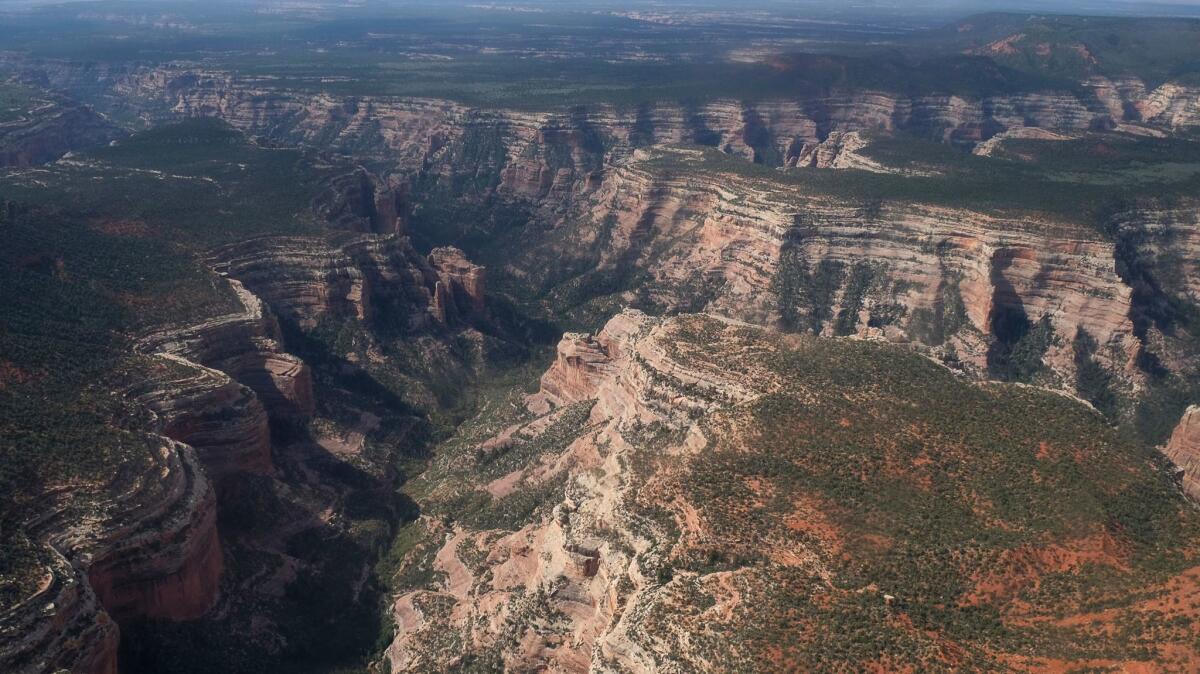Trump plans to shrink two national monuments in Utah, senator says

- Share via
Reporting from Salt Lake City — President Trump has notified Utah’s senior Republican lawmaker that he plans to shrink the boundaries of Bears Ears and Grand Staircase-Escalante national monuments, the first hint of Trump’s plans under a controversial review of national monuments established under prior Democratic administrations.
Sen. Orrin G. Hatch said Trump assured him during a phone call Friday that he planned to reduce the size of both monuments, scenic gems of southern Utah wilderness that had been protected from mining and other development by President Obama and President Clinton.
The announcement was met with delight in southern Utah — where there has been strong opposition to federal controls on the use of public lands — and with vows by environmental groups to block the boundary changes.
“I was incredibly grateful the president called this morning to let us know that he is approving Secretary Zinke’s recommendation on Bears Ears,” said Hatch, referring in a statement to Interior Secretary Ryan Zinke, who has undertaken a study of national monuments across the country.
The president’s assurance on the boundary changes was greeted with sentiments of gratitude and resignation in San Juan County, Utah, where the Bears Ear monument is located.
“We’re happy about the direction he’s going,” said Phil Lyman, a certified public accountant and county commissioner. “It’s going to be tough and it’s been tough. As soon as Obama designated the monument there were road closures and other changes. For somebody who lives in the actual wild West, campgrounds and latrines and paved picnic spots are not what locals see as progress.”
A coalition of environmental legal groups across the country anticipated that Trump would follow through on Zinke’s recommendation to alter boundaries in Bears Ears and Grand Staircase. They say a lawsuit is ready to defend provisions of two statutes that oversee management of public lands.
The 1906 Antiquities Act gives presidents the authority to preserve public lands as national monuments. The 1976 Federal Land Policy and Management Act ensures that Congress has the authority to decide management and uses of the public domain.
“There is nothing in the law that says the president can reduce or revoke boundaries of national monuments,” said Christopher Krupp, an attorney in Seattle with WildEarth Guardians, a member of the coalition. “He has to be granted that authority by Congress.”
Presidents have previously altered a few monument boundaries. In 1915, President Wilson reduced Mount Olympus National Monument by over 300,000 acres. The last change occurred in 1964 when a net of 1,000 acres was shaved from Bandelier National Monument in New Mexico. The 1976 Federal Land Management Act essentially put a stop to further boundary changes.
The president’s message to Hatch today resets clear political skirmish lines in the increasingly pitched confrontation over the administration’s campaign to ease restrictions and assist the West’s resource-extractive industries. Bears Ears encompasses potentially rich reserves of uranium. Grand Staircase is a potential source of billions of tons of coal.
Earlier this week, the Interior Department’s five-year strategy for opening more of the West’s 500-million-acre public domain was made public. It calls for ensuring “energy and economic security for America” as part of the administration’s campaign for “American energy dominance.”
The agency says it plans to achieve that objective by considering repeal or replacement of regulations “that eliminate jobs, inhibit job creation, are outdated, unnecessary, ineffective, [or] impose costs that exceed benefits.”
The struggle over national monuments in Utah is emblematic of the differing views of the uses for the West’s public lands. The administration is sympathetic to local residents who resist more federal control of lands, and the needs of mining industries.
Steve Bloch, the legal director of the Southwest Utah Wilderness Alliance notes, though, that Utah’s five magnificent national parks are aggressively marketed as jewels in the state’s thriving recreation and tourism industry.
“It’s important to recognize that four of the five national parks in Utah started as national monuments,” he said. “Nobody in their right mind today would say that is a bad idea.”
Yet Hatch said a move to recalibrate the monuments also has benefits.
“We believe in the importance of protecting these sacred antiquities, but Secretary Zinke and the Trump administration rolled up their sleeves to dig in, talk to locals, talk to local tribes and find a better way to do it,” Hatch said.
Bears Ears National Monument, 1.4 million acres of public land surrounding a pair of stunning mesas in southeastern Utah, was given national monument status by Obama in December 2016.
Grand Staircase-Escalante, renowned for its paleontological resources, was established by President Clinton in 1996 near Utah’s border with Arizona.
Zinke in September proposed changes for a total of 10 national monuments, and the outcome of the full review is expected soon.
Schneider is a special correspondent.
UPDATES:
3:20 p.m.: This story was updated with reaction to the report on the monuments, plus historical context.
This story was originally published at 12:45 p.m.
More to Read
Sign up for Essential California
The most important California stories and recommendations in your inbox every morning.
You may occasionally receive promotional content from the Los Angeles Times.









